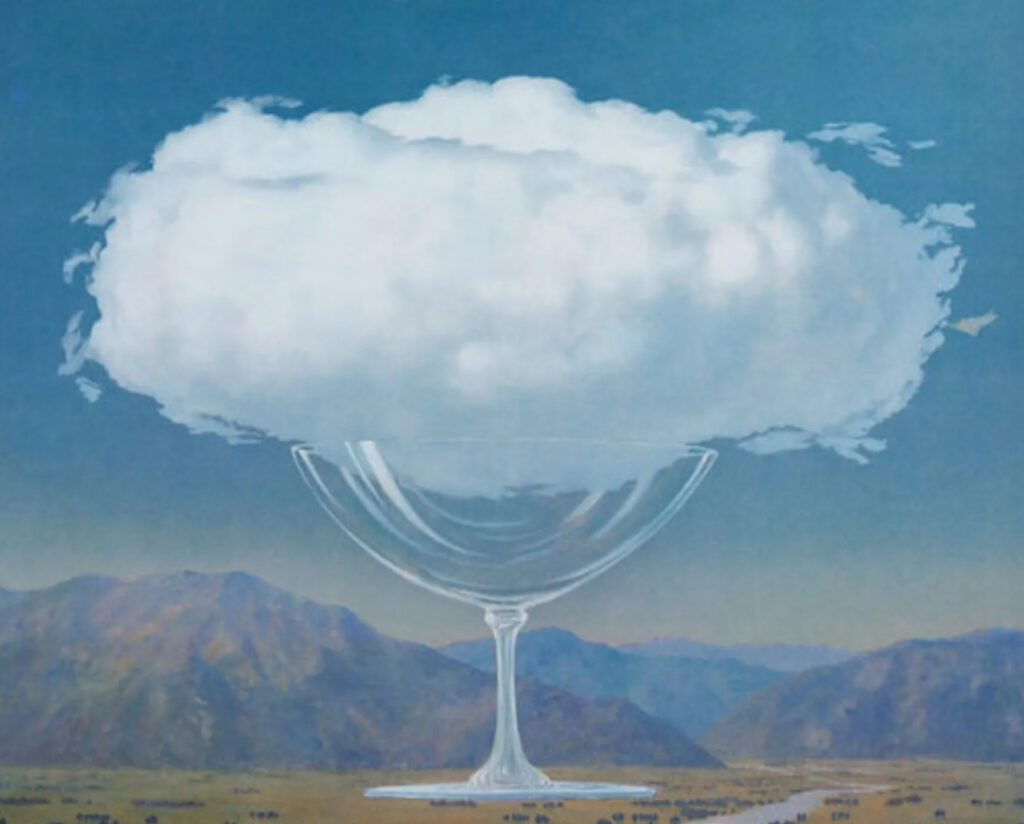In the museum of the mind, René Magritte occupies a paradoxical gallery: his works are instantly recognizable yet perpetually obscure, as if clarity itself were a carefully constructed illusion. With “Heartstrings,” a 2010 Belgian lithograph on paper bearing the spectral lineage of Magritte’s surrealist genius, we are offered not simply a reproduction, but a ritual reengagement with his central themes—longing, rupture, and the false comfort of visual certainty.
Though posthumous, this print is far from a lifeless artifact. It is a reanimated conversation, orchestrated in Belgium, Magritte’s homeland, where the chill of surrealism feels endemic. This lithograph is neither a historical footnote nor a novelty; it is a philosophical machine, etched on paper and set loose in a world still trying to decode the tension between appearance and meaning. The title “Heartstrings” invites an immediate misreading—suggesting sentimentality—but under Magritte’s lens, it becomes another deliberate misdirection. Love, in his visual lexicon, is as dangerous and destabilizing as it is tender.
The Lithograph as Return: 2010 and the Rebirth of a Vision
Produced decades after Magritte’s death in 1967, Heartstrings enters the world at a curious moment in art history. The 2010s ushered in a new cycle of hyper-visual culture: Instagram aesthetics, meme logic, the commodification of irony. In such a context, Magritte’s work—once the realm of philosophical painters and Parisian salons—has become unexpectedly contemporary.
What makes this lithograph potent is not just its visual composition, but its medium. Lithography has always been a democratic form—a way to bring art into domestic and intellectual spaces without stripping it of meaning. But with Magritte, even reproduction feels original. In this 2010 edition, printed with high fidelity to the artist’s original palette and texture, the material becomes part of the message. Lithography mirrors the very ambiguity that defines Magritte’s work: it is real, and not real; authentic, yet multiplied; immediate, yet mechanical.
Deconstructing “Heartstrings”: Symbol, Structure, and Subversion
In Heartstrings, we encounter a tableau typical of Magritte’s private mythology: an ordinary setting laced with psychological landmines. The composition (variations exist depending on the series) commonly centers around a figure—often faceless or obscured—standing against a landscape pierced by improbable elements: clouds shaped like violins, a suspended apple split open to reveal an anatomical heart, or curtains drawn back to expose a mirror reflecting nothing.
The titular “heartstrings” are rarely literal, and when they are—say, rendered as red cords extending from a torso—they appear too literal, forcing the viewer to question their symbolic weight. Is this a representation of love’s emotional entrapment? Or a surgical dissection of sentimentality? Magritte consistently weaponizes familiarity, and here, the heart is not a romantic emblem but a decoy, its strings pulling on systems of belief rather than affection.
This tension—between intimacy and disassociation—is central to Heartstrings. As with The Lovers or Memory, Magritte subverts the visual language of love. The figures in his world may kiss, but their faces are shrouded in cloth; they may gaze, but into reflections that do not return their image. Love, in Magritte’s universe, is not illumination—it is eclipse.
Belgium’s Influence: The Grey Sublime
To understand the climate from which Heartstrings emerges, one must revisit Belgium—not just as Magritte’s birthplace, but as a key to his psychological atmosphere. Belgium is a nation shaped by linguistic fault lines and historical shadowlands. It is both Germanic and Latin, Catholic and secular, Romantic and pragmatic. This duality feeds directly into Magritte’s sensibility: the profound dressed as banal, the surreal lodged in the everyday.
The lithograph’s execution in Belgium in 2010 reactivates this tension. It is a national exhalation—Belgium reproducing its most iconic enigma at a moment when the country itself was grappling with constitutional breakdowns and cultural fragmentations. In this light, Heartstrings becomes not only a personal meditation but a political ghost—a quiet scream into the chasm between unity and identity.
Lithographic Integrity: Precision as Disturbance
Technically, the Heartstrings lithograph is executed with care that borders on reverence. The use of fine-grain archival paper, oil-based inks, and traditional presswork ensures that each impression retains the depth, sharpness, and tonal nuance of an original canvas. But the question persists: can a mechanical process contain emotional truth?
Magritte would answer with a smirk. His career was defined by painting objects in flat, airless space, yet loading them with intellectual gravity. The lithograph thus becomes the perfect host: its apparent sterility masks a profound metaphysical unease. The precise outlines, the measured gradients, the lack of brushstroke—all suggest clarity. But clarity, under Magritte’s eye, is a mask that hides something darker.
The Surrealist Sentence: Text as Betrayal
Magritte often embedded language into his work, not as explanation, but as sabotage. In The Treachery of Images, the text beneath the pipe—“This is not a pipe”—does not clarify the image; it shatters its authority. In Heartstrings, whether textual elements appear within the visual field or merely haunt the title, the same tactic persists. Language, for Magritte, is suspect. It pretends to clarify, but often only further alienates the viewer from certainty.
If the word “heartstrings” appears within the composition—say, painted onto a building or stitched into a floating banner—it does so as a decoy. A trap. The term evokes sentiment, yes, but in a Magrittean context, that sentiment is immediately deferred, destabilized. The heartstring doesn’t pull the viewer in emotionally—it pulls them out of complacency.
Collector’s Object, Philosopher’s Puzzle
What does it mean to own a lithograph like Heartstrings? On one hand, it is a luxury object: editions of this kind, authenticated and Belgian-printed, are highly collectible. They decorate boardrooms, private libraries, and university walls. On the other hand, they are weapons of philosophical inquiry—designed not to soothe, but to unsettle.
To possess Heartstrings is to live with a mirror that reflects not your image, but your assumptions. Is this a piece of beauty, or a critique of beauty? Is the heart here an object of affection, or a symbol of pain? As with all of Magritte’s work, the answer lies not in the image, but in the act of viewing. Interpretation is not optional—it is demanded.
Emotional Distance, Visual Intimacy
What makes Heartstrings enduring is its capacity to feel deeply while showing almost nothing. There is no grand gesture here, no obvious agony or passion. The emotional register is distilled, not diluted. Like much of Magritte’s best work, it functions on delay: it hits the viewer after they have looked away.
This is the paradox of the piece. The visual vocabulary is clean, precise, even antiseptic. But the emotional undertow is devastating. Heartstrings offers no catharsis, only repetition and return—a looping question: what does it mean to feel in a world where appearances deceive?
Magritte in the 21st Century: A Mirror for Postmodernity
In 2010, the world stood on the cusp of digital saturation. Images proliferated, but meaning thinned. Heartstrings, arriving in that climate, behaves like an antidote. It rejects speed in favor of sustained contemplation. It denies resolution. It demands attention, suspicion, and doubt.
Magritte’s surrealism was never a movement—it was a mindset. And Heartstrings carries that mindset into a new century, where AI generates art and truth is algorithmically blurred. In this light, the lithograph becomes not nostalgic, but fiercely contemporary.
Pulling at the Edges of Reality
Heartstrings is not a sentimental work. It is not soft, or comforting. It is Magritte at his most surgical—cutting into the vocabulary of love, exposing the gears beneath the metaphor. And yet, it remains beautiful. Not because it tells us something sweet, but because it reminds us that images lie—and in that lie, we glimpse something true.
The 2010 lithograph stands not only as a continuation of Magritte’s legacy but as a refraction of it—bent, repeated, reconsidered. Printed in Belgium, executed with precision, and titled with provocation, Heartstrings extends the surrealist project into our era of simulation and suspicion.
It does what all great art should: it unsettles the known, seduces the eye, and leaves the soul asking questions it cannot name.
No comments yet.








